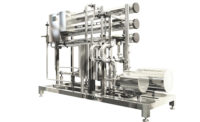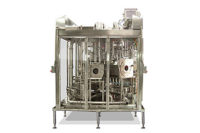Shelf life can be defined as the length of time a pasteurized product remains in good quality at a specified temperature after it is placed in its final container. Sanitation, for purposes of this article, refers to prevention of microbiological hazards and more specifically ensuring a hygienic environment.
Effective sanitation programs include good manufacturing practices (or GMPs), and with the Food Safety Modernization Act, GMPs have been modified and are required to be implemented to manage food safety.
GMPs and environmental controls play a large role in ensuring products meet shelf-life expectations. Yet, with closed systems, the removal of soil particles from equipment surfaces by mechanical, manual or chemical methods (cleaning) will be most effective in meeting those code goals. In addition, the treatment of a cleaned equipment surface with a chemical (sanitizing) or physical agent to destroy disease- or spoilage-causing organisms and reducing total vegetative cell populations to a safe level will take it to the next level.
Four components of cleaning
There are four components necessary for effective cleaning (removal of soils and 90% to 99% of bacteria) and they are all application-specific. These components should be determined through an appropriate cleaning validation process and should be completed on all cleaning processes on the raw and pasteurized side to ensure removal of the microbiological hazards that can reduce shelf life.
Contact time on the surface is one critical component. Efficiency can increase productivity, but reducing cleaning time can cause long-term issues. When product is built-up or burned on, longer contact of the cleaning chemical on the surface will minimize soils and harborage sites for bacteria.
For clean-in-place (CIP) systems, this time is determined when validation of the CIP system is completed and is programmed into the process. Clean-Out-of-Place (COP) processes have the opportunity for variation, so building verification checks into the COP process can ensure the equipment comes into contact with the detergent for an appropriate amount of time.
Action or physical force exerted onto the surface in the case of CIP is determined by flow rates. Both 3-A Sanitary Standards and the Grade A Pasteurized Milk Ordinance provide guidance on specific minimum flow rates required to obtain turbulent flow within a pipe line.
For COP processes, COP tanks offer agitation and the physical force of the water. All items must be disassembled prior to being placed in a COP tank, and the tank should not be overfilled with large pieces of equipment or overcrowded. Both actions will reduce effectiveness of cleaning.
Additional physical force such as hand cleaning can be very effective in the removal of soils as concurrent to that scrubbing. Visual inspection is necessary to ensure the piece of equipment is clean.
A third component is using the recommended amount (concentration) and type of chemical or cleaner. It is critical to condition the water by reducing the surface tension and/or control the water hardness to ensure the water can effectively clean. The correct amount of chemical is also needed to remove the soil. Working with a chemical supplier to identify the appropriate type of detergent and concentration specific to the equipment, water, type of soil and type of cleaning should ensure removal of microbiological hazards that reduce shelf life.
The fourth component is temperature. Believe it or not, hotter is not always better. Too high of temperature can have a detrimental effect on the cleaning chemical. For example, too high of a temperature when chlorinated chemicals are used will cause the chlorine to gas off. Each cleaning procedure should outline the temperature ranges for effective cleaning and a verification step would be to ensure those ranges were met.
Sanitizing comes next
Sanitizing or taking care of what remains after cleaning is an important process within the quest to improve shelf life. Bacteria are a leading cause of shelf-life issues, and sanitizing can reduce the amount of bacteria on a surface, but a soiled/dirty surface cannot be sanitized!
If effective cleaning will remove 90% to 99% of bacteria from a surface, the next key step is to reduce it via sanitizing to at least 99.9% removal of bacteria. The effectiveness can be measured and verified through microbiological testing. A properly sanitized surface should have ≤ 2 CFUs/square centimeter.
As with cleaning, a sanitizing process should be developed in partnership with a chemical supplier to determine if heat or chemicals (or a combination) is appropriate based on the application. The most commonly used sanitizers work by cooking to kill the bacteria (heat), breaking open the cell to kill the bacteria (oxidizers), and smothering to kill the bacteria (zwitterions – acids and quats).
Good sanitation includes multiple programs and facets within a facility. The cleaning and sanitizing of equipment is one of the most critical processes within that program and can significantly progress a product to meeting and potentially exceeding shelf-life goals, ultimately resulting in satisfied consumers and brand loyalty.



